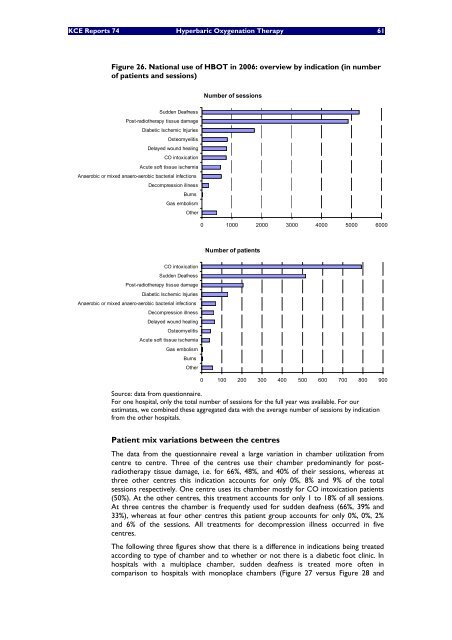Hyperbare Zuurstoftherapie: Rapid Assessment - KCE
Hyperbare Zuurstoftherapie: Rapid Assessment - KCE
Hyperbare Zuurstoftherapie: Rapid Assessment - KCE
Create successful ePaper yourself
Turn your PDF publications into a flip-book with our unique Google optimized e-Paper software.
<strong>KCE</strong> Reports 74 Hyperbaric Oxygenation Therapy 61<br />
Figure 26. National use of HBOT in 2006: overview by indication (in number<br />
of patients and sessions)<br />
Sudden Deafness<br />
Post-radiotherapy tissue damage<br />
Diabetic Ischemic Injuries<br />
Osteomyelitis<br />
Delayed wound healing<br />
CO intoxication<br />
Acute soft tissue ischemia<br />
Anaerobic or mixed anaero-aerobic bacterial infections<br />
Decompression illness<br />
Burns<br />
Gas embolism<br />
Other<br />
CO intoxication<br />
Sudden Deafness<br />
Post-radiotherapy tissue damage<br />
Diabetic Ischemic Injuries<br />
Anaerobic or mixed anaero-aerobic bacterial infections<br />
Decompression illness<br />
Delayed wound healing<br />
Osteomyelitis<br />
Acute soft tissue ischemia<br />
Gas embolism<br />
Burns<br />
Other<br />
Number of sessions<br />
0 1000 2000 3000 4000 5000 6000<br />
Number of patients<br />
0 100 200 300 400 500 600 700 800 900<br />
Source: data from questionnaire.<br />
For one hospital, only the total number of sessions for the full year was available. For our<br />
estimates, we combined these aggregated data with the average number of sessions by indication<br />
from the other hospitals.<br />
Patient mix variations between the centres<br />
The data from the questionnaire reveal a large variation in chamber utilization from<br />
centre to centre. Three of the centres use their chamber predominantly for postradiotherapy<br />
tissue damage, i.e. for 66%, 48%, and 40% of their sessions, whereas at<br />
three other centres this indication accounts for only 0%, 8% and 9% of the total<br />
sessions respectively. One centre uses its chamber mostly for CO intoxication patients<br />
(50%). At the other centres, this treatment accounts for only 1 to 18% of all sessions.<br />
At three centres the chamber is frequently used for sudden deafness (66%, 39% and<br />
33%), whereas at four other centres this patient group accounts for only 0%, 0%, 2%<br />
and 6% of the sessions. All treatments for decompression illness occurred in five<br />
centres.<br />
The following three figures show that there is a difference in indications being treated<br />
according to type of chamber and to whether or not there is a diabetic foot clinic. In<br />
hospitals with a multiplace chamber, sudden deafness is treated more often in<br />
comparison to hospitals with monoplace chambers (Figure 27 versus Figure 28 and

















